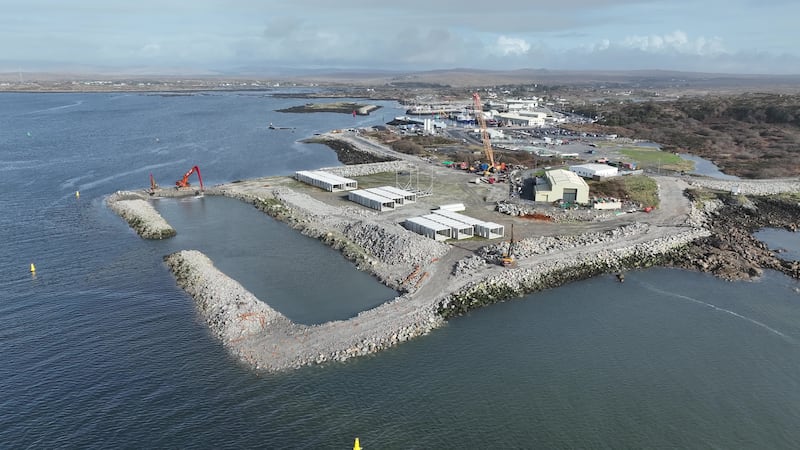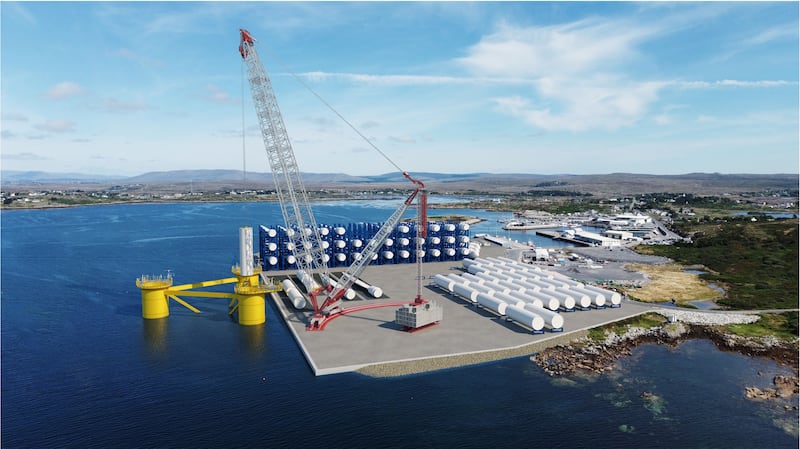The road to Galway is one long traffic jam in the morning, according to chairman of Ros an Mhíl port development committee Cathal Groonell. And come evening, it just goes in reverse. He estimates 90 per cent of south Connemara’s working population is locked into that daily grind.
Developing the fishery port as an operations and maintenance hub supporting offshore wind energy off the west coast offers an unprecedented opportunity for local employment, he says.
Irish ports are racing to be ready to play their part in building and servicing offshore wind farms – with fixed bottom turbines first and floating technology later. These are first critical steps in building a new sector predicted to be worth at least €38 billion to the Irish economy over their lifetime.
Ros an Mhíl may not be seen as being among front-runner locations but a large team backing its case, including Údarás na Gaeltachta, believes it has a distinct advantage over rivals on grounds of its proximity to sites off the western seaboard and the fact that it is already undergoing a €30 million redevelopment.
‘The development of the deepwater pier is a once in a lifetime opportunity to build a new industry, not alone for Ros an Mhíl but also for south Connemara’
— Cathal Groonell, chairman of Ros an Mhíl port development committee
With a relatively small additional investment, the local committee that has been campaigning for upgraded facilities for more than 20 years believes it can be made fit for purpose, opening the door to the single biggest investment to date in Connemara, starting with development of a wind farm by Corio Generation – aka Fuinneamh Sceirde Teoranta (FST) – on Sceirde Rocks off Carna and Roundstone.

It’s a cart before the horse exercise, as developers won’t come unless the infrastructure is there. They want to build and service their operations from strategically located points around the coastline with deep water, long quaysides and extensive adjoining landbanks.
Groonell is acutely conscious of the port’s decline in recent times but driven by what it can become: “The development of the deepwater pier is a once in a lifetime opportunity to build a new industry, not alone for Ros an Mhíl but also for south Connemara,” he says.
As managing director of Iasc Mara fish processing plant, he led a thriving business in the 1980s employing more than 400 people. “A huge number of boats were landing fish, all with local crews, families living locally and on Inis Mór.” Boats were gradually bought up, mainly by Killybegs-based operators, falling fish quotas didn’t help and business went into decline.
The port became the main departure point for tourists going to the Aran Islands and a busy marina was built, but that is very seasonal.
Ros an Mhíl’s main advantage, he says, is the ability to have a deepwater pier able to handle very big vessels engaged in fishing and offshore energy. “You’re able to build it for €30 million because of the natural depth, the shelter and services going right to it.”
[ Redeveloped Connemara port 'has capacity to become offshore wind hub'Opens in new window ]
Ports will need hundreds of millions of euro in State funding to meet the needs of the offshore wind sector and the clock is ticking fast because of legally binding climate targets – five gigawatts of fixed offshore wind with 2GW of floating in development by 2030.
“Offshore wind operators have said yes, they can operate out of Ros an Mhíl. That gives me great confidence ... We need offshore wind energy in a very serious way as a country. There is no reason why it shouldn’t happen here,” he says.
Groonell sees a synergy between Ros an Mhíl, Galway port, which is already expanding, and Aran, a natural shelter for shipping.
The Department of Agriculture, Food and the Marine got planning permission for a berth length of 200 metres; 12-metre depth at quayside, eight metres in the navigation channel and a turnaround circle of 200 metres. However, in the current construction contract, the Department of the Marine restricted depth to 10 metres at the berth and seven metres in the channel with turnaround of 150 metres due to cost constraints and its focus on satisfying fishery needs only.
While they can work with this if needs be, says marine development specialist Mark White who is advising the local port development committee, provided the channel is widened to 100 metres at a cost of only €400,000, an additional €12 million would facilitate full utilisation of the planning permission. That would make it navigable for all boats, including those used to support large-scale construction such as jack-up barges that put turbines in place on the sea bed.
As currently designed, it imposes extra constraints, especially in future-proofing it for floating wind projects.
Aran Energy Co-op director Dara Molloy believes the Sceirde project is Ros an Mhíl’s opportunity to optimise what it has to offer.
“We have to face the reality that there will be certain services and things that we can’t provide... while working in co-operation with Galway port and other willing partners,” he concedes. There is a narrow window to get there but he is reassured by Minister for Energy Eamon Ryan’s support for Ros an Mhíl as an offshore hub.
The decline in fishing contrasts with the Aran Islands seeing a population increase for the first time since the Famine and full employment, mainly in hospitality. He is dismayed, however, that port and offshore development “is complicated by all the different departments that have to be involved in any decision-making”.
The co-op is not against wind farms ‘but we want them to be positioned and looked after in such a way that they do no damage or the least possible damage to wildlife, whether it’s birds or whales or other fish in the sea’
— Dara Molloy, Aran Energy Co-op director
Asked if local people have concerns about the FST wind farm, he says: “They do: fishermen certainly do... that underwater cables will affect spawning, that fishing vessels would catch the cables and [on] locating wind turbines in the middle of good fishing grounds. The developers have been in discussions with those stakeholders... So hopefully it’ll all be sorted.”
The co-op is not against wind farms “but we want them to be positioned and looked after in such a way that they do no damage or the least possible damage to wildlife, whether it’s birds or whales or other fish in the sea”.
He feels local communities, impacted by wind farms at sea, should be given a share in their ownership. The Government facilitates community groups owning onshore wind or solar farms, he notes. On compensation, he says: “That’s like throwing sweets to the kids.”
Corio’s senior development director, Séamus McCabe, says that how a community benefit fund worth €3.5 million a year is distributed will be determined by an independent committee but he expects it will support cross-community collaboration. Their memorandum of understanding with Údarás is part of building an enduring relationship because the project “needs the community to accomplish it”.
Údarás director Rónán Mac Con Iomaire cites analysis indicating potential for more than 600 jobs. With its economic, community and linguistic mandate in the Gaeltacht, he is undaunted by the task of establishing a new sector. In the early 1990s, there was no audiovisual sector in Connemara; now it is internationally recognised. They upskill communities to work in such sectors and the blue economy is a key priority – with offshore energy being an evolution of that.
Údarás already has a serviced business park site in the port for the offshore industry and is looking to develop a centre of excellence around training “to ensure human capital is available locally”.
A big aspect will be bringing people back home. There is a significant maritime diaspora from the area, including marine engineering, Mac Con Iomaire says, “but employment opportunities have been around the North Sea. So when we put something up on LinkedIn, you keep seeing likes from Connemara surnames in Denmark and Scotland and Germany”.
Living in Scotland for the past 10 years, McCabe – an Irish speaker – is aware of that skills pool.
They hope to submit a planning application for the wind farm this year, he adds. It will cost of up to €1.5 billion with 450MW capacity – enough power for 350,000 homes. Power will be conveyed by cable (offshore and onshore) to Moneypoint in Co Clare, “probably the strongest point in the national grid”.
Surveying was done last year working with local fishermen to minimise impact. More will be done this year as part of an exercise informing the design. Construction, they hope, will start in late 2026.
It’s a requirement under ORESS-1 auction process, where they won a State contract, that it help meet 2030 targets. Construction is likely to take up to three years as it depends on “weather windows”. Size of turbines will be in the final design, “which is some years away”, but will be determined by local wind speed and the best available fixed bottom technology, McCabe adds.
On recent market and supply chain problems, he says: “I don’t think it would unnerve us ... when you talk to the turbine suppliers, they’re very positive about investing themselves in providing extra capacity. There’s certainly a large pipeline of projects globally for offshore wind.
“It’s probably more of a challenge ensuring that you work collaboratively to achieve the 2030 targets.”
On industry warnings that capital may move elsewhere as Irish offshore development is too slow, he says: “I don’t think there’s any shortage of capital in the market ... There is shortage of high quality projects that can be delivered. Institutional investors are really keen to invest in the sector as an asset class.”
Micheál Ó Clochartaigh, FST’s stakeholder and consent manager who is from Carna, says there is significant buy-in in an area that has struggled due to rural disadvantage, emigration and lack of employment opportunities, “while people are genuinely tuned into climate change and the implications of national and international targets”.
Ros an Mhíl playing a role with other deepwater ports along the western seaboard should be seen as “a real and crucially important opportunity nationally”, White adds, but this must be backed by strategic refocus at the highest levels of Government. “There are a huge number of Government departments with important and even key roles in offshore renewable energy. The effective delivery of our potential and, in the short term, more importantly, of our 2030 and 2050 targets will require not only joined-up thinking – but joined-up management.”
The current cross-departmental delivery taskforce is helpful but simply not enough, he says.
“It is essential that a senior civil servant be appointed at overarching Government level, in other words in the Department of the Taoiseach, who has the responsibility and the authority to ensure all departments pull their weight in the delivery of offshore renewable energy with urgency, ambition and determination, and that the Government puts in place a clear and measurable policy to implement and deliver this.”
This will require some legislation and amendments to current roles and responsibilities, White says, “but such is the potential for offshore renewables in Ireland, this should be done with maximum urgency”.
The Department of Marine says Ros an Mhíl is a “fishery harbour centre” operated under legislation to support fishing industry. A deepwater quay is being delivered in line with planning permission and cost benefit analysis, it adds. It is one of three centres identified in a policy statement on facilitation of offshore renewable energy by commercial ports issued by Minister Ryan. “However, the extent to which the fishery harbour centres will be involved remains to be seen... The department has regard to the role of the commercial ports and the need to ensure State aid rules are observed.”
‘It will take a political decision [again] ... If we don’t get this, we might as well dump Ros an Mhíl out to sea’
— Nioclás Ó Conchubhair, former Fianna Fáil senator and local resident
Work in facilitating development of port infrastructure capable of supporting offshore renewable energy at commercial State ports “is led by the Department of Transport and is a key deliverable under the Offshore Wind Delivery Taskforce”, it says.

Work on Ros an Mhíl’s expansion is being undertaken by Galway company Ward & Burke, which is using an innovative levelling frame to put in place caissons filled with a cement replacement known as GGBS in the quay wall, ensuring a lower carbon footprint. Its managing director, Pádraig Burke, says Irish companies are capable of delivering much of the offshore infrastructure required but Government support is needed.
Former Fianna Fáil senator Nioclás Ó Conchubhair, who runs a building and electrical goods business in nearby Casla, says it is exciting to see a deepwater facility finally being developed. Cross-party support made it possible and additional “not huge money” can ensure it plays a big role in scaling up the West’s offshore wind energy.
“It will take a political decision [again] ... If we don’t get this, we might as well dump Ros an Mhíl out to sea,” he says.
McCabe lists the port facilities in Ireland needed to support this emerging industry. “There’s a role for Ros an Mhíl. There’s a role for Cork. There is a role for Shannon-Foynes and the Dublin ports. There is a big prize there and everyone can have some of it.”
- Listen to our Inside Politics Podcast for the latest analysis and chat
- Sign up for push alerts and have the best news, analysis and comment delivered directly to your phone
- Find The Irish Times on WhatsApp and stay up to date











